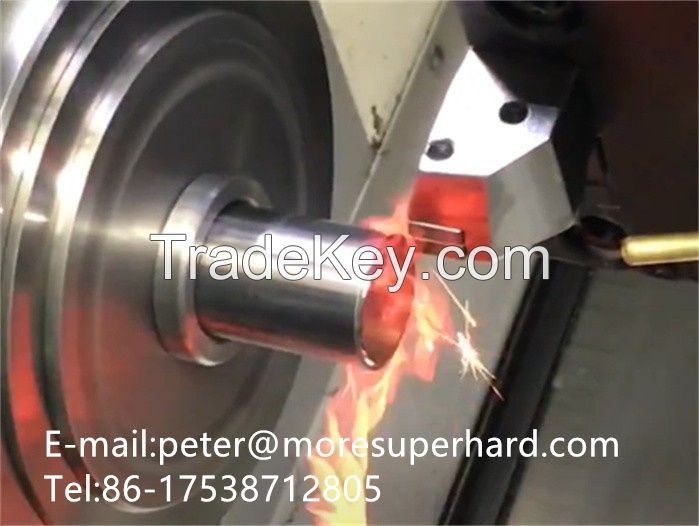Ceramic grade tools are typically classified into three
general categories: oxide, nitride,
and matrix
ceramics.
Oxide ceramics are alumina-based and are generally used in
roughing and finishing applications of the cast and gray
irons. Increasingly, oxide ceramics are being used in dry
machining applications at high speeds. This is due to the
advancements within materials science, including the
incorporation of whisker-based materials.
Nitride ceramics exhibit extremely high fracture toughness
and are used for roughing and semi-roughing of cast irons
under harsh conditions, such as when there is considerable
starting and stopping that would typically increase
fracturing.
CMCs contain ceramics mixed with other hard materials like
cemented and titanium carbides. They can also contain
reinforcing whiskers and other materials to increase wear
resistance and toughness under hot machining conditions.
These are commonly referred to as SiC-whisker reinforced.
Alumina reinforced with SiC whiskers is the toughest and
most resistant to thermal shock of the oxide-based ceramics
due to the extremely high tensile strength of the SiC
whiskers. It offers the additional benefit of being able to
be run without coolant, thus making dry machining a common
application while also being able to offer an increase in
machining rates up to 800%.
All ceramic cutting tools have excellent wear resistance
at high cutting speeds.
There is a range of ceramic grades available for a
variety of applications.
Oxide ceramics are aluminum oxide-based (Al2O3), with
added zirconia (ZrO2) for crack inhibition. This
generates a material that is chemically very stable but
lacks thermal shock resistance.
(1) Mixed
ceramics are particles reinforced through
the addition of cubic carbides or carbonitrides (TiC,
Ti(C, N)). This improves toughness and thermal
conductivity.
(2) Whisker-reinforced
ceramics use silicon carbide whiskers
(Siew) to dramatically increase the toughness and enable
the use of coolant. Whisker-reinforced ceramics are ideal
for machining Ni-based alloys.
(3) Silicon
nitride ceramics (Si3N4) represent another
group of ceramic materials. Their elongated crystals form
a self-reinforced material with high toughness. Silicon
nitride grades are successful in gray cast iron, but a
lack of chemical stability limits their use in other
workpiece materials.
These benefits lead to increases in efficiency. For
example, many machinists would slow cutting speed if
temperatures were to approach maximum carbide limits. It is
the opposite for ceramic tools, which excel in higher
temperature conditions.
Advantages
of silicon nitride ceramic cutting tools
Compared with carbide cutting tools, silicon nitride
ceramic cutting tools have obvious advantages, which are
shown in the following aspects.
â— The HRA value of silicon nitride ceramic cutter is
usually 91-93 (HRA is used to represent the hardness
index of soft and hard materials), so it has good wear
resistance and can be used to process high hard materials
that are difficult to be processed by traditional tools
or cannot be processed at all, such as various kinds of
hardened steel and hardened cast iron with the processing
hardness up to HRC65 (60HRA = 20HRC).
â— It can be used for rough and finish machining of high
hardness materials, as well as for high-impact machinings
such as milling, planning, and intermittent cutting.
â— The cutting tools made of silicon nitride ceramics
can be cut at high speed to realize the function of
milling for grinding for high hard materials, simplify
the processing technology and improve the processing
efficiency, so as to save time, electricity, number of
machine tools and plant area and other effects.
â— The silicon nitride ceramic blade has less friction
with metal when cutting, which makes it difficult to
stick to the blade and the roughness of the workpiece is
low.
â— The tools durability is several times or even dozens
of times higher than that of traditional tools, which
reduces the number of tool changes during machining,
ensures the uniformity of the workpiece, and also ensures
small taper and high accuracy.
â— The cutting tool consumes the most abundant element
silicon in the crust as raw material, which can save a
lot of strategic metal materials such as tungsten,
cobalt, and titanium.


Applications
of silicon nitride ceramic cutting
tools
Auto parts processing
A series of parts such as milling cylinder cover,
cylinder sleeve, and automobile brake disc are
processed with composite silicon nitride ceramic blade,
which can improve the efficiency. For example, a
milling cutter can increase its speed from 92r/min to
275r/min.
Bearing machining
The rolling bearing adopts the technology of rough,
fine, quenching, rough grinding, and fine grinding for
a long time. For example, after hardening to 63HRC, the
blank of the GCr15 precision forging bearing will be
deformed and uneven and will get stuck in the rough
grinding of the automatic grinding machine directly,
and even burn the spindle of the grinding machine in
serious cases. The finishing process of the bearing
ring before quenching and the rough grinding process
after quenching are combined into the finishing process
of the ceramic cutter after quenching, which will make
the workpiece fully meet the required size and
geometric accuracy, realize the substitution of
grinding by car and greatly improve the processing
efficiency.
Hard cast iron processing
If the composite nitride ceramic tool is used to
process the cold cast iron roll, the tool life is
increased four times than that of cemented carbide; it
can be used to process superhard nickel alloy spray
welding roller bushing, which can greatly improve the
cutting efficiency and speed, save time and cost and
improve economic efficiency.
Other fields
In the fields of machinery, metallurgy, mining, railway
locomotive, aerospace, precision instruments, molds,
etc., the technology can be reformed by using silicon
nitride ceramic cutting tools to greatly improve
production efficiency, save energy and reduce cost.







